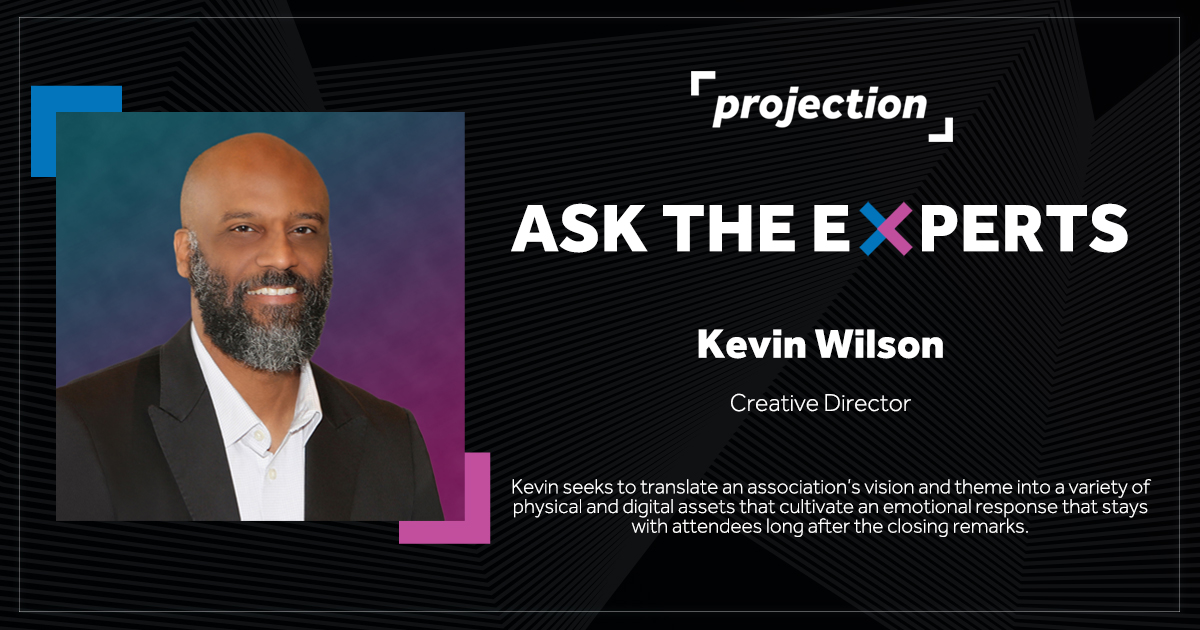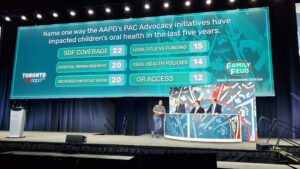
Since the pace of change in the meetings and events industry seems to be stuck on overdrive, we wanted to spend some time with experts in the field who can share what they are seeing, trends coming up (and going away) and how attendees are reacting to all of it.
This is our second post in our “Ask the Experts” series. (The first, a great discussion about association event trends with Dane Lonchay, can be found here.) Over the next several months, we will be talking to experts who hold different roles across the industry and sharing their insights here.
Our expert today is Kevin Wilson, Creative Director at Projection. In his role, Kevin seeks to translate an association’s vision and theme into a variety of physical and digital assets that cultivate an emotional response that stays with attendees long after the closing remarks.
Q: Projection is so much more than just an AV Company. Can you explain your role in bringing all of the pieces together to make great events happen?
A: In my role as Creative Director, I work closely with our clients to help their events come to life. We are more than just a gear house; we don’t simply show up with gear to showcase a PowerPoint deck. We ask questions about the goals of the event and the story the client is trying to tell. Then, we design and execute an experience that their audience/membership will remember forever. My job is to foster that experience and be the glue between the planner, communications, and marketing teams, and our insanely talented production team to create an unforgettable event.
We always start with an initial meeting, where we ask a lot of questions, take notes, and start to process what type of event we want to create together. We give the client the floor, and let their mind go. We talk about themes, messaging, the attendee journey, and where we can get creative.
Q: What types of assets do you create for events?
A: People instantly think about the on-screen graphics or digital signage they see at events, but we create all different types of production assets.
We create things like opener videos––both for the entire show and for individual speakers. We do dramatic speaker segments, stage renderings, title slates, lower thirds, videos, and even live entertainment elements like dance or musical performances.
The best events are the ones where we can get more creative with the show’s assets. For example, we produce the American Geophysical Union Honors Ceremony. This event honors Earth and space scientists for their incredible career achievements. Last year, instead of focusing solely on the honorees’ achievements, the team decided to focus on their impact in the scientific community. We sought out and conducted virtual interviews around the globe with other scientists who had been mentored and personally impacted by the honorees/award recipients. The videos we produced with these recordings were full of impactful messages; as a result, the award ceremony took on a much more personal tone, which made for a more engaging and community-affirming experience.

Game Show at the 2024 AAPD Annual Meeting
For the American Academy of Pediatric Dentistry (AAPD), we created a game show segment as a vehicle for Academy leadership to better communicate key messages in a fun and engaging way. It was a huge hit that set the tone for the entire event.
With today’s technology, there is no reason to turn to static slideshows or a stationary speaker giving a run-of-the-mill earnings report. There are so many alternatives that drive engagement and create a memorable experience that the audience will keep talking about over the next days, weeks and even year.
Q: What are a few trends you are seeing in events today?
1: Strategic scriptwriting
Meetings aren’t just cheesy jokes and speaker intros anymore. Successful planners are taking a hard look at what their members need and want, and what the association needs to communicate, and weaving all of that into a purposeful story that drives the event forward.
2: Performances
I see a lot of meetings that want more tangible experiences. A performance can be almost anything––music, theatrics, readings. The ones that have the biggest impact are those with a strong theme behind them. When a performance is recorded with high-quality production elements, they can live on – and be used in multiple capacities – for years, making it worth the initial investment.
3: Gamification
This has been on the radar for a while now, but in some ways, meetings are still catching up to this trend. Today, we are seeing associations use gamification in two ways.
One is through existing platforms like trivia applications, bingo, etc., which generally happens on screen during the attendee walk-in. There might be questions such as, “Where’s the best place to get your CEO’s message?” and people can answer on their phones and the answer will come up on the screen. We create the graphics for those.
The other way is through a gamification performance. These are more elaborate, and often target pain points so members can learn through fun. For example, the AAPD game show was scripted to allow for the association’s core messages to be delivered. The questions focused on sharing details and information about the association, initiatives, and member benefits, with the goal to help members better understand the benefits available to them. The result: members ended up learning in a really fun way.
4: Multi-use media
More clients are investing in videos that are story-driven and high in production value. They cost more to make up front, but they can also be used more than just one way, one time. When these videos tell a great story, they live on post-show in the social world, association archives, or in the common space of the event. For example, we created a 50th anniversary video for an association event that their marketing and communication teams were able to use in many other capacities throughout the year. There is value in high-quality content beyond the scope of the event, and more people are starting to see that.
5: LEDs with big content
A projection screen is just a rectangle (or at best another simple shape), but an LED display is a huge surface with which you can do a lot of different configurations, even layering them to create interesting spaces. You can create a lot of content that is big, bright and bold.
But the possibility of creating more and different content is why people really love LEDs. You can stick an LED wall anywhere––you don’t have to compensate for distance from the projector or worry about people walking in front of it. LEDs can be massive. For example, we have done LED walls that were more than 100 feet wide. We have used LEDs to create an entrance/exit to the stage. It’s a much cleaner look, which you can’t always accomplish with projectors.
6: Audio as part of the experience
There are a lot of practical effects that can add to an event without busting the budget. One that we have been using more and more is sound. Placing the speakers in a different way or using more bass can help tell more-in depth stories, create emotions and even give the audience goosebumps.
Right now, we are toying with audio and how it works for the walk-in. Traditionally, it’s a countdown and the announcer might say, “Ladies and gentlemen, please find your seats.” We are looking at ways to lead the audience into the opening performance with the sound and incorporating the walk-in music into the opening piece. Using just sound, we can get people energized when they might not otherwise be.
Q: Is there content your team is producing that you feel is important or impactful?
A: Definitely. It’s an election year, and there is high anxiety, especially for the LGBTQ+ community. For example, we have two events being held in Florida where the content we are creating must be subtle but purposeful.
Q: What are you doing differently today than in years past?
A: I think the pandemic was a catalyst. A big challenge was bringing energy to the online space. We essentially created internet TV, so we had to find ways to keep audiences engaged. It opened the door for more theatrical performances happening on stage. Audiences love coming to the general session and being wowed.
Q: What are some things that organizations can do to achieve better results?
A: It is all about the story and theme of your event. Look at what you want to accomplish, and tell a compelling story around that.
It’s easy to get caught up in the numbers – attendance, membership, revenue, and sponsors – but this doesn’t give you the full picture of your event.
At a boring event, people are just scrolling through their phones. At an engaged event, the only reason people have their phones out is to take pictures. You don’t want to spend all that money for people to zone out.
When the event planner has a purposeful theme and way to engage the audience, they will be cheering and having a good time. These days everyone, no matter the generation, is having amazing real-life experiences regularly. They don’t want to come to a room and be talked at. Physically, you have a huge space to work with. Emotionally, you have their undivided attention. Do something with it!
Q: How do you help clients think more strategically?
A: As the Creative Director, I understand that we have to put the budget first. So, we stay patient, and talk about what we can do with the budget available. Often, a client’s idea of “big” stops at an LED wall. But we can give them ideas and make something that goes beyond what is expected. Budget is important, but it doesn’t have to be a reason to avoid having a conversation about what’s possible. More than likely, we can do more than they expect.
We also try to give feedback about what we see when we attend the shows. Once we see what we are working with, how their audience reacts, and the state of their event, we can brainstorm further for next year.
Q: What is something you wish every association event planner brought to the table?
A: An open mind to creating an experience for their attendees. Some planners feel like if the audio/visual elements are present and working, everything is fine. There is so much more we can do to add focus, color, and drama.
Q: What are the tech tools you couldn’t live without in planning and executing events?
A: I feel like as a team, we are a little bit misunderstood. We have access to every tech tool under the sun, but we only use the tools we need to make the event happen. The execution is what makes the event great. I can’t live without our online communication tools, because that’s how we connect to each other and our clients – and how we make their vision come alive.
Custom Technology Solutions for Events and Why They Matter
with Simon Tuck
More from “Ask the Experts”
[Part One] Talking Association Event Trends with Dane Lonchay
[Part Three] Custom Technology Solutions for Events and Why They Matter with Simon Tuck
